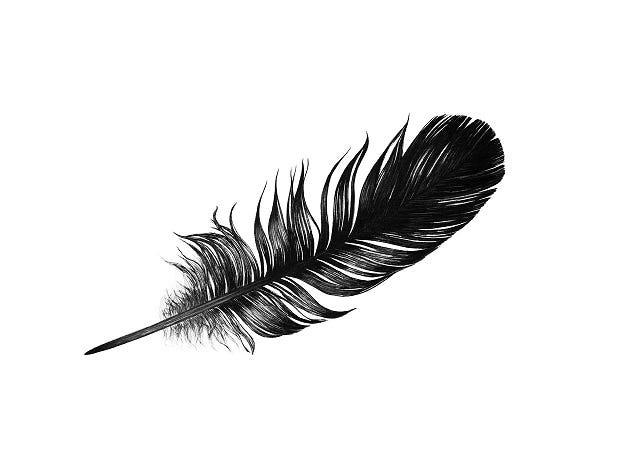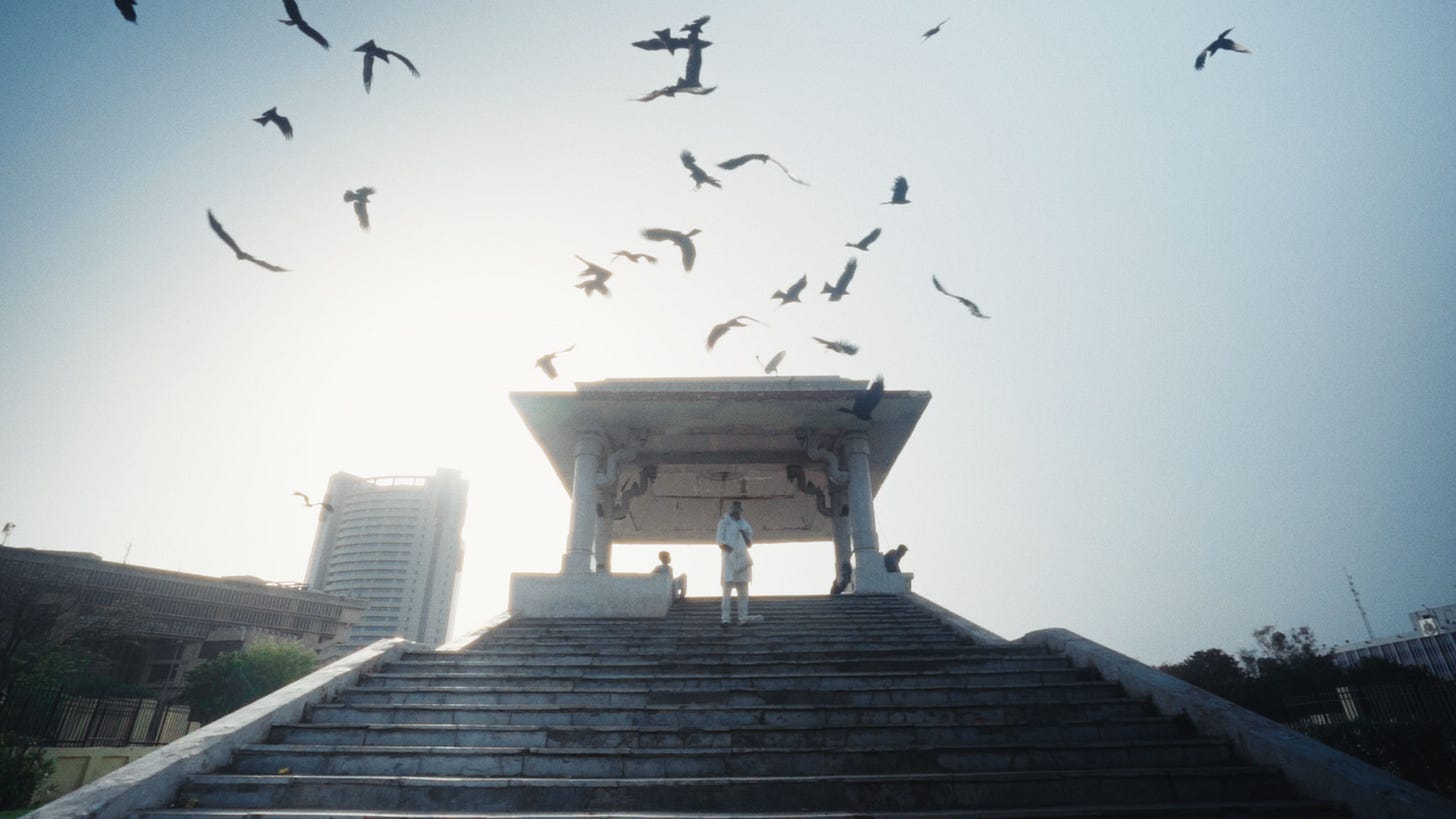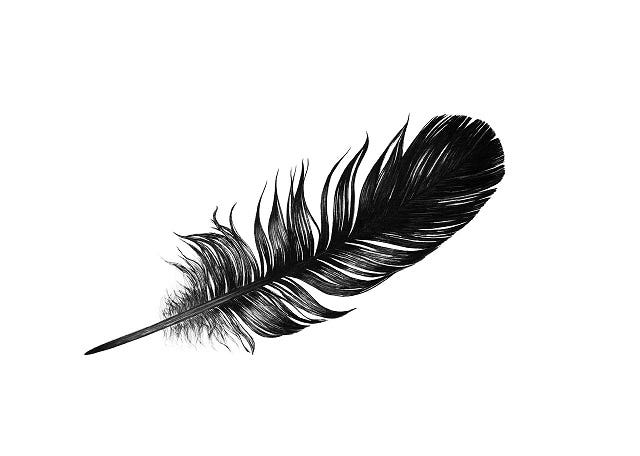The Community of Air - redux
3/28/24 – The importance of noticing
Hello everyone:
Heather and I are away all week, and there’s no time to put together something new for you. For all new subscribers, and there are a lot of you, here’s an updated piece from a year ago that I’m sure you’ll like. The bonus here is that the writing serves as a recommendation for an amazing documentary. Enjoy.
As always, please remember to scroll past the end of the essay to read some curated Anthropocene news.
Now on to this week’s writing:
Heather and I watched the documentary All That Breathes last year. It follows the brothers Mohammad Saud and Nadeem Shehzad, with their assistant Salik Rehman, as they care for wounded birds in their small home in a Delhi slum. Aesthetically, All That Breathes is a visual poem, perhaps the most beautifully filmed documentary I’ve ever seen. Narratively, it stays close to the bone, favoring silence over dialogue but is always intensely, captivatingly meaningful.
Where All That Breathes truly shines, though, is at the meeting ground of empathy and ethics. Watching the brothers struggle to do their good work, the film sings precisely along the line between hope and heartbreak, caring and catastrophe, that defines our place in a radically disrupted natural world.
Over the last twenty years, Nadeem and Saud have provided devoted care to an astonishing number of birds: more than 20,000 since 2010, and now about 2,500 per year. They treat mostly black kites, the ubiquitous small raptors that haunt the filthy skies of Delhi. Their lives revolve around this care, funded on a shoestring budget through a small family business selling soap dispensers, plus the occasional grant. They are poor, in a poor neighborhood. Their facilities (until recently) were crude, the work constant, and the reward entirely a matter of faith.
From this unlikely sanctuary they have, as the film’s director Shaunak Sen told the Times, “front row seats to the apocalypse. Birds are literally falling out of the sky into their tiny basement.”
Here’s the film’s marketing description:
In one of the world’s most populated cities, cows, rats, monkeys, frogs, and hogs jostle cheek-by-jowl with people. Here, two brothers fall in love with a bird – the black kite. From their makeshift bird hospital in their tiny basement, the "kite brothers” care for thousands of these mesmeric creatures that drop daily from New Delhi’s smog-choked skies. As environmental toxicity and civil unrest escalate, the relationship between this Muslim family and the neglected kite forms a poetic chronicle of the city’s collapsing ecology and rising social tensions.
Heather and I are not the only people to fall in love with All That Breathes. It is the first documentary to win both the World Documentary Grand Jury Prize at the 2022 Sundance Film Festival and the L’Oeil D’or (“Golden Eye”) award at Cannes. It has won many other prizes as well. And it was nominated for a Best Documentary Oscar in 2023.
In a Times newsletter, writer Somini Sengupta nicely captured the essence of the film, particularly in this passage about the brothers and Salik, who
care for their neighbors (in this case, nonhuman neighbors) in a makeshift bird hospital in a tiny basement on a narrow street in a cheek-by-jowl neighborhood of Delhi. The brothers treat their wounds. They grind meat to feed them. They nurse them back to health. When they can’t, they dig graves.
And therein lies a lesson for many of us in the era we call the Anthropocene: The brothers do their part.
Sen calls it noticing. Noticing who is there, who is hurt, who needs care.
“They’re constantly surrounded by that kind of awareness of things that are very palpably living, injured, wounded, breathing,” Sen said.
And it’s this noticing I want to talk about here. It’s not just the brothers whose lives full of stress and joy exist on the threshold between hope and heartbreak, caring and catastrophe. It’s the film itself.
The gorgeous cinematography is rooted in that noticing and caring. From the opening shot, the camera attends to the margins of urban life where the more-than-human world persists. It notices life everywhere, small to large, millipede to rat to feral pig to cow, often finding it in trash-strewn puddles and other water sources. The camera reflects, quite literally, upon the human war against the tapestry of life, and documents the tragic, beautiful struggle to persist.
Which means that the context for the brothers’ struggle to maintain their practice against financial, logistical, and personal odds is that same struggle to persist. Nadeem, Saud, and Salik are woven into the more-than-human world by their empathy. They are the turtle awkwardly clambering through the landfill; they are the black kites navigating a sky full of horrors.
Saud and Nadeem explain on their website, Raptor Rescue, that as young men they decided they could no longer ignore the birds’ suffering. They found little support in the community, but were determined to let their noticing upend their lives. That’s the radical step not enough of us take, crossing the line from empathy to ethics, and never retreating.
While thinking about the film this week, I had one of those moments of coincidence that make writers happy. A conversation on the radio – NPR in some form – referenced a well-worn and much-needed bit of Jewish wisdom:
Do not be daunted by the enormity of the world's grief. Do justly, now. Love mercy, now. Walk humbly, now. You are not obligated to complete the work, but neither are you free to abandon it.
You are not obligated to complete the work, but neither are you free to abandon it. While this has always been true in human affairs, particularly in the endless struggle for social, political, and religious justice, it literally and metaphorically infuses the air we breathe now in the Anthropocene. From the toxic air of Delhi that chokes both Nadeem’s young child and the black kites to the warmed atmosphere acidifying the oceans and rupturing ecosystems from Pole to Pole, we are still in the early days of the necessary multigenerational task to heal the wounds of this absurd and tragic human era.
“Delhi is a gaping wound and we are a tiny Band-Aid on it,” says Nadeem. He might as well be talking about the globe and the countless other small-scale solutions people like he and Saud (and you and I) are enacting to counteract the large-scale chaos.
The gift we receive when we truly notice the suffering of the natural world is the realization that we don’t need to cross a line to get there. We’re already there. Despite our boxed-in lives – cubes we call home, car, store, office – we’re in the tapestry and inseparable from it. We belong to the world. It does not belong to us, though the last two centuries of ecological erasure have been driven by that delusion.
Nadeem reminds us that we don’t need religious, social, or personal reasons to care for animals. “Life itself is kinship,” he says. And in a metaphor rooted in two decades of caring for birds, he reminds us that the atmosphere connects all that breathes: “We’re all a community of air.”
All That Breathes is on HBO and elsewhere. Check it out, and find your place in the community.
As a follow-up, I recommend you read Good Grief, the essay I wrote last year on the heels of this one. It’s an exploration of what good news in this era really means, how we must acknowledge our grief for the disruption of the living world, and how we move forward regardless with open eyes and open heart toward the best future we can make.
Thanks for sticking with me.
In other Anthropocene news:
From the Xerces Society blog, to protect pollinators and other insects please wait as long as possible to get out the rake and do your yard and garden spring clean-up. Ground-nesting bees and others are still hiding out in the leaf litter on cold nights, while chrysalides are hanging on inside standing dead plants. Read the article for details, but since insect emergence depends on where you live they suggest you wait until after a) the apple trees are done blossoming, b) it’s warm enough to plant tomatoes outside, and c) it’s time to mow the lawn (but don’t mow during No Mow May!).
From Inside Climate News, an extraordinarily important study in the New England Journal of Medicine lays out just how damaging the petrochemical industry has been, and still is, to human health. Only 5% of the 350,000 chemicals derived from fossil fuels have been subjected to rigorous safety tests, despite the well-known linkage to a broad range of human illnesses, especially from endocrine-disrupting chemicals (EDCs). I’ll let some early paragraphs in the article speak the hard truth here:
Studies have linked EDCs to increased risk of a range of health conditions, including abnormal neurodevelopment (for example, attention deficit hyperactivity disorder and lower IQ), fertility problems (poor sperm quality and impaired ovarian development), cancer (breast, prostate and kidney), early puberty and metabolic diseases (early-onset diabetes, obesity and non-alcoholic fatty liver disease), among other serious ills.
Hormones act at very low levels to control the body’s basic functions throughout life, starting with prenatal development. It doesn’t take much for chemicals that act like hormones to trip up precisely timed developmental stages, when a single cell rapidly divides into the trillions that build the body. The tiniest disruptions can derail development to cause birth defects…
Rates of neurodevelopmental disorders, diabetes, chronic respiratory disease and cancer have increased by up to 150 percent, Woodruff reported, as the chemical industry churned out billions of pounds a year of bisphenols, phthalates and PFAS, aka “forever chemicals,” PBDE flame retardants and other hormonally active compounds. Just last month, researchers linked prenatal exposure to pesticides and other EDCs to increased risk of congenital heart defects.
Petrochemicals have also taken an astonishing toll on lifespan.
Chemical pollution, from fossil fuel extraction and the petrochemicals added to hundreds of products—pesticides, plastics, food contact materials, cleansers, cosmetics and toys, to name a few—may kill at least 1.8 million people a year, researchers reported in The Lancet in 2022.
Experts say there is no safe level of exposure to these chemicals across the population.
From
at , another of his excellent pieces articulating the unity of climate and ecology. The entire climate discussion, from the IPCC to corporate boardrooms to school classrooms, has been narrowed down to a purely physical greenhouse-gas-warms-the-Earth analysis and technical search for solutions. But as Rob explains, while describing the career of noted climate scientist Roger Pielke, Jr., there is no way to separate our changes to the living Earth from the disruption of atmospheric norms. We need a different approach, one that understands that the biodiversity and climate crises are the same crisis, or as Rob puts it, one “that sees ecosystems as more than helpless victims of a CO2-run climate, but as active regulators of a biophysical climate and our greatest ally in restoring the climate to its natural condition.” Rob is a true believer in this understanding, and is working hard to help us see it too. We need to listen:For myself, one of the most convincing things about the ecology/climate overlay has been my own trajectory in studying it. Simply put, I started out with climate and ended up in ecology. Now I see relationships everywhere, the world more alive because of them. The atmosphere, rather than a distant, inanimate layer of gasses, has come to feel more like an extension of Earth itself, not floating mechanically over it, but dynamically upheld by it. The sky I once stood under I now stand inside of. Land and atmosphere have become woven into a single living system.
It’s hard to overstate the effect this has had on me. It is science, but the implications verge on the poetic and spiritual. The more I divine the interweave of life and climate, the more awe I feel at the life around me. And this leaves me wondering what is possible for others. What might grow in the human psyche if such understanding where to exist at large? And why doesn’t it? Why at this very late date do we still keep such a distance from the living beings and relationships around us?
From The New Republic, how a minor rule change to fuel economy standards by the EPA led to the stupidity of much larger cars and trucks roaming American streets and highways. The rule change set different standards for different vehicles, so the industry simply changed their business model to make more money and avoid stricter standards. As the article puts it,
American autos aren’t bigger because consumers have suddenly embraced off-roading, the construction trades, or home improvement projects. They’re bigger because automakers want to escape regulations.
From the Atlantic, how the northern U.S. should be preparing for the millions of climate migrants who will flee north as southern cities become unlivable and agriculture becomes untenable. The article is focused on Michigan, but it’s worth reading for all of us. New England, northern Europe, and Russia, for example, may be transformed by both climate and the migrants moving in response to it. The writing is adapted from On the Move: The Overheating Earth and the Uprooting of America by Abrahm Lustgarten.
From CNBC, and article and video on why American EVs will be a goldmine for tire manufacturers. EVs are heavier and quieter, which means tires wear out 20% faster and seem noisier inside the vehicle. Also, badly designed tires can reduce vehicle range by 10%-15%. Worse, the car/truck manufacturers are forcing the market toward much larger (and much more profitable) large SUVs and trucks. Already, tire prices for EVs are 50% higher than for gas-powered cars.
From Inside Climate News, a rush to permit the injection of millions of tons of CO2 in Louisiana and elsewhere threatens to blow out some of the millions of old, poorly-capped wells that have been abandoned around the country. CO2 injection may well prove to be another billion-dollar boondoggle in which CO2, like the methane that’s currently seeping out of all these old wells, bubbles right back out into the atmosphere. “It’s not a question of whether they’re going to leak,” said one expert, “it’s a question of how much, how often, and whether it’s an acceptable level of leakage.”







I remember this essay well. And my comment is unchanged from the one I made back then. You are one of the finest lyrical writers on Substack. You were then and you remain so. This essay is proof of that.
Good people. We all can make a difference if we make an effort. Wondering what you think of the recent decision by the official Geological Academic overlords deciding not to label this era as Anthropocene? With all the solid scientific evidence - seems very political as in serving some special interests $ behind the scenes. Regardless - many scientists and writers will continue to use the term and speak truth to power.